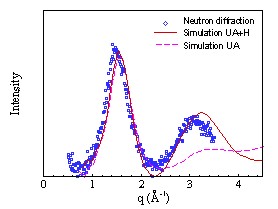 Group Members Group Members 
|
 |
Chunxia Chen
|
 Email:
Email:
Duration in group: 2001 - 2007
Research Summary
Intermolecular Packing and Segmental Dynamics
in Poly(ethylene oxide)/Poly(methyl methacrylate) Blends
Introduction
There has been an increasing interest in polymer blends during last decades due to the
development of new materials with desirable properties including flexibility,
processing temperature, viscosity, etc. The packing structure and dynamics are
important because they control the polymer properties; however, they are not
well understood so far. Our research aims to develop a molecular-level
understanding of packing and short-time dynamics in polymeric materials. This
work seeks to address the following two questions: What is the packing structure
and short-time dynamics of the investigated materials? How is the packing
related to the relaxation processes? How do the structure and dynamics of the
polymer change with the addition of another polymer? Poly(ethylene
oxide)/Poly(methyl methacrylate) (PEO/PMMA) blends are chosen as the system
because the two polymers have weak interactions (? ? 0) and a large difference
in glass transition temperatures (?Tg?180K). This large Tg difference will make
it easy to identify each component’s influence from the blend dynamics.
Investigated methods
Though a lot of techniques including NMR, IR, and
dielectric spectroscopy have been carried out to investigate polymer dynamics,
most of the techniques can not provide the spatial information necessary to
associate the relaxation processes with specific molecular motions. Molecular
dynamics (M.D.) simulation and neutron scattering experimental techniques can
simultaneously resolve temporal and spatial scales, and when taken together they
become more powerful in probing packing structure and short times dynamics.
Molecular dynamics simulations provide the exact location and identity of all
atoms at all times, while neutron scattering techniques measure the exchange of
energy and momentum between the neutrons and the investigated sample. Both
techniques access times scales of picoseconds to nanoseconds, and length scales
of a few angstroms. The observables that describe structural and dynamic
properties of the given system, such as static structure factor S(q) and dynamic
structure factor S(q,t) (where q is scattering vector and is related to distance
r between particles as q=2?/r) can be calculated from simulation and also
obtained from neutron scattering experiments. Therefore the simulation model can
be verified by experimental data. On the other hand once the reliability of the
simulation model has been assessed, it can be used to interpret the experimental
data and predict the information that cannot be directly obtained from
experiments.
Our group has employed several neutron scattering
techniques including high flux backscattering [HFBS], Disk Chopper
time-of-flight [DCS], neutron spin echo [NSE] and BT7 triple axis to measure the
static and dynamic properties of PEO/PMMA blends, as well as their pure
components. In conjunction with experiments we are also working on the molecular
dynamics simulation of the polymers by united atom models [UA] (i.e. the CH3,
CH2 and CH groups are considered as a single unit) and all atom model [AA] (i.e.
every atom in the system is considered explicitly). Currently we finished the UA
modeling on pure components. The graph below gives an example of the comparison
between the experimental and simulation results, where the UA model is used. It
indicates that our united atom simulation model captures the structure
characteristics of simulated PEO. We are testing the AA model now. The effect of
blending on the dynamics will be explored in the future using the UA and AA
simulation models and neutron scattering techniques.

Figure 1. Comparison of the
static structure factors of PEO from UA simulation, the UA simulation with
hydrogen added afterwards and neutron diffraction experiments at the same
temperature of 343K.
|
